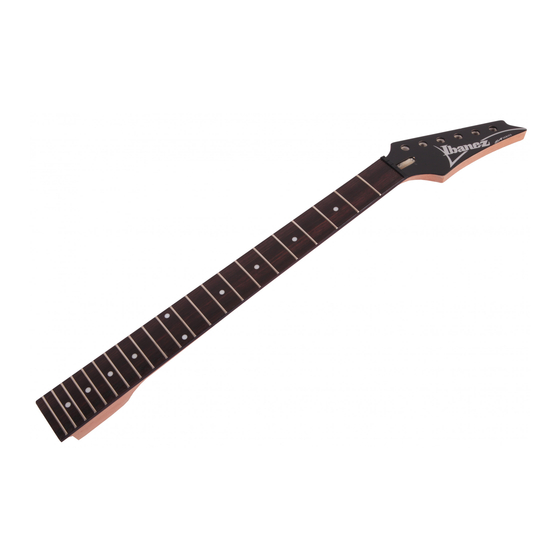
Advertisement
Quick Links
ADJUSTING THE NECK
The neck bears the tension of the strings. The curvature of the neck is subtly affected not
only by the tuning state and string gauge, but also by changes in temperature and hu-
midity. For this reason, the neck contains an internal truss rod that allows the curvature
to be precisely adjusted.
Tune the strings accurately, hold the guitar in playing position, then press the first string
at the first fret and at the fret that is nearest to the point where the neck joins the body,
as shown in Fig. 1. (It will be more convenient to use a capo at the first fret.) Measure
the gap between the string and fret at the eighth fret. Do the same for the sixth (lowest)
string. For each string, the gap should be in the range of 0.3-0.5 mm (a slight bow in
the neck). Although symptoms may vary depending on the type of neck and on how the
neck is joined to the body, problems such as excessive string height, string buzz for high
notes, or intonation difficulties may occur due to an excessively bowed neck (Fig. 2 A),
which will cause this gap to be larger. Conversely, problems such as insufficient string
height, string buzz for low notes, or muted notes may be due to a neck that is bowed
in the reverse direction (Fig. 2 B), which will cause this gap to be smaller. Try to refrain
from simply making a visual judgment. Rather, determine the problem based on the
symptoms that occur, and make the appropriate adjustment. The truss rod nut is located
at the headstock end of the neck. Using the Allen wrench or socket wrench included with
the guitar, tighten the nut toward the right (Fig. 3 C) if you want to bend the neck in the
convex direction, or loosen the nut toward the left (Fig. 3 D) if you want to bend the neck
in the concave direction. Make adjustments in quarter-turns, alternating steps of tuning
and adjustment.
Caution
You must exercise appropriate care when adjusting the neck. If the truss rod
nut does not turn as you expect, or if you are unable to make adjustments
accurately, do not attempt to force the adjustment; contact your dealer or the
Ibanez company.
PICKUPS
By adjusting the pickup height, you can make fine adjustments to the volume and tone. For
a commonly used pickup height, adjust the adjustment screws (Fig. 4 E) on both sides of
the pickup with a Phillip screwdriver to create a space of 2-5 mm between the pickup/pole
piece and the strings pressed at the last fret. However, this adjustment will depend on your
playing style or on the characteristics of your amp, so you should make this adjustment while
listening to the actual sound. For pickups of the type that allows the pole piece to be adjusted,
you can correct the volume balance for each string. (Note that you can only make adjustment
within a given adjustment range.) Depending on the type of pole piece, use either an Allen
wrench (Fig. 4 F) or a slot head screwdriver, whichever is suited for the pickups.
The volume will increase as the distance between the pickup and string decreases, but if
the spacing is too close, you may get cracked sounds or the string may buzz due to the
magnetic field of the pickup. Conversely, increasing the distance between the string and
pickup will produce a clearer sound with less distortion, but the high-frequency range
may be attenuated and the volume may drop.
For the LZ series of Ibanez active pickups, the pickup characteristics and equalizer bal-
ance are adjusted according to the model hosting them. It is designed to enable correct
action to be taken by making correct combinations of the pickups installed on the guitar
and the equalizer to be used. No other combination will work. Do not use this series with
LZ pickups used with some other models or in conjunction with active pickups produced
by other manufacturers. This is also applicable to equalizer selection.
Fig. 1
Fig. 2
D
C
C
D
Fig. 3
E
E
Fig. 4
8th fret
F
Advertisement

Summary of Contents for Ibanez NECK
- Page 1 Tune the strings accurately, hold the guitar in playing position, then press the first string at the first fret and at the fret that is nearest to the point where the neck joins the body, as shown in Fig. 1. (It will be more convenient to use a capo at the first fret.) Measure the gap between the string and fret at the eighth fret.
- Page 2 However, conditions under which the guitar is played greatly vary depending on the thickness of strings, neck condition, and tuning. In order to correct subtle interval diversions arising from these differences, you will need to carry out fine adjustment for the string length (intonation adjustment).









